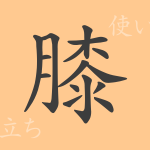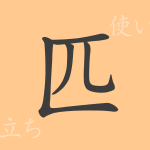“`html
Our bodies are complex and precise structures, and one part that plays an indispensable role in daily life is the “肘 (hiji, elbow).” In this article, we will focus on the 常用漢字 (jōyō kanji, commonly used kanji) “肘 (hiji)” and explore its origin, meaning, usage, as well as idioms and expressions involving the elbow. Let’s deepen our understanding of the richness of the Japanese language and the importance of the elbow, a part of our body.
Origin of 肘 (hiji)
The kanji 肘 (hiji) is a character that was transmitted from ancient China. Its shape is derived from the combination of a person’s arm and hand. Originally, “肘 (hiji)” referred to the joint of the arm, and the same term was used for the forelimbs of animals. Over time, this kanji was introduced to Japan and developed uniquely within the Japanese language.
Meaning and Usage of 肘 (hiji)
肘 (hiji) refers to the joint located in the middle part of the human arm. Specifically, it is the part where the humerus and the bones of the forearm connect, playing an essential role in bending and extending the arm. In everyday conversation, expressions such as “肘をつく (hiji o tsuku, to rest one’s elbow),” “肘掛け (hijikake, armrest),” and “肘を強くする (hiji o tsuyoku suru, to strengthen one’s elbow)” are commonly used. Besides referring to a part of the body, it is also used metaphorically.
Reading, Stroke Count, and Radical of 肘 (hiji)
The kanji 肘 (hiji) does not have a specific on’yomi (Chinese reading) and is read as “hiji” in kun’yomi (Japanese reading). This kanji has a relatively simple structure with 10 strokes. The radical is “肉 (nikuzuki, meat),” classifying it among kanji related to flesh or meat.
- Reading: Kun’yomi – hiji
- Stroke Count: 10 strokes
- Radical: 肉 (nikuzuki)
Idioms, Expressions, and Proverbs Using 肘 (hiji)
Expressions involving 肘 (hiji) include the following:
- 肘鉄 (chū tetsu) – Striking someone forcefully with the elbow. Also refers to the strike itself.
- 肘掛け (hijikake) – The part of a chair or seat designed for resting the arm.
- 肘鉄を食らわす (hijitetsu o kurawasu) – Literally means to hit with the elbow, but metaphorically it means to treat someone harshly.
- 肘を曲げる (hiji o mageru) – Literally refers to the action of bending the elbow, but it can also mean to change one’s intention or reconsider.
Summary of 肘 (hiji)
The 肘 (hiji) is a crucial part of our daily movements and is also used in various expressions in the Japanese language. The movement of the elbow symbolizes flexibility and strength, which is reflected in its linguistic usage. Although we use our elbows unconsciously in daily life, we hope this article helps you re-recognize its importance and the depth of the language.
“`

























